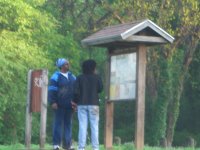Happenings Around Waco
There's no telling where I might be, what I might see, what picture I may take or what route I may make. You'll find some of it here. Waco, Tx., my hometown.
Saturday, April 29, 2006
Wednesday, April 26, 2006
Waco, Tx makes National News Concerning Jesse Washington Lynching
Picture of the mural with the hanging tree with noose between the two buildings.

In Waco, a Push To Atone for The Region's Lynch-Mob Past
By Sylvia Moreno
Washington Post Staff Writer
Wednesday, April 26, 2006;
WACO, Tex. -- Two memorials stand on the site of one of the most notorious incidents in the history of this central Texas city. One commemorates the 114 lives lost in the tornado of 1953; the other, the 1897 shootout between a newspaper editor and a local judge who offended the journalist's Baptist sensibilities.
But Heritage Square, as the downtown plaza is known, is also where 17-year-old Jesse Washington was tortured and lynched on May 15, 1916. The act of mob violence was so gruesome that it was dubbed the "Waco Horror" in Texas newspapers. National and European periodicals noted the event of a black farmhand dragged through city streets, mutilated, burned alive and lynched outside City Hall before the mayor, the police chief and 15,000 cheering townspeople.
Ninety years later, despite some opposition, a group of Waco residents and the city's white business establishment have decided it is time to make amends not only for Washington's lynching but also for "the history of mob violence in Central Texas."
"The practice of lynching profoundly dehumanized not only victims of lynching, but also its perpetrators and acquiescent by-standers," reads a resolution adopted this week by the city's Lynching Issue Task Force. "Whereas by healing the wounds of our shameful legacy through acknowledgment and apology, Waco and McLennan County can end our documented history of silence," it continues, in part.
A city of 125,000 whose neighbor to the west is President Bush's ranch in Crawford, Waco has a current population that is half white and about a quarter black. It now joins communities across the United States that are confronting traumatic racial histories. With legacies of lynchings, deadly race riots or killings of civil rights workers gone unpunished, these cities are trying to comprehend and assuage the lingering impact of such violence.
"This is something that's hung over my family for years," said Nona Baker, the 60-year-old great-niece of Sank Majors, a 20-year-old black man who was hanged by a white lynch mob from one of Waco's bridges in 1905. "I would like to have had a little memorial service down at that bridge and maybe a plaque. But most of all, I would like an apology."
Often led by black elected officials, a younger generation of whites who grew up in a post-segregation society and core civil rights activists, racial reconciliation groups have been established in a number of U.S. cities confronting their violent past. They include Duluth, Minn., where three black men were lynched on one day in June 1920, and Greensboro, N.C., where a South African-style truth and reconciliation commission is examining the November 1979 killings of five labor organizers by Klansmen and American Nazi Party members.
Racial reconciliation has taken various forms. A decade ago, survivors of the 1923 massacre of the black community of Rosewood, Fla., received state-funded reparations. In Virginia, special state scholarships have been offered to African Americans denied education in the 1950s and 1960s when some schools closed rather than desegregate. Georgia and Tennessee have developed a civil rights and slavery curriculum for their public schools. The "Call to Justice" for the 1964 killings of three civil rights workers near Philadelphia, Miss., included an official apology to the victims' families.
"It's these measured steps that are getting us further down the road" toward racial rapprochement, said Susan M. Glisson, director of the William Winter Institute for Racial Reconciliation at the University of Mississippi. "Each community has to decide for itself what to do. . . . There's no one answer."
The lynching of Washington is one of 500 recorded in Texas from 1880 to 1930, a period with almost 4,700 lynchings nationwide. The Washington case began with the murder of Lucy Fryer, a white woman living with her farmer husband in Robinson, a small community on Waco's southern edge. She was found bludgeoned and Washington, who worked the Fryers' cotton farm, allegedly confessed to the killing. Illiterate and believed to be mentally retarded, the 17-year-old signed a confession with an X and led authorities to the presumed weapon, a blacksmith's hammer.
To stave off an angry mob that gathered when the teenager was arrested, authorities promised a quick resolution to the case. Washington was indicted in 30 minutes. Four days later, he received an hour-long trial in the McLennan County Courthouse. The jury deliberated four minutes and found him guilty of murder.
Just as the judge was to pronounce a death sentence, about 1,500 angry spectators jamming the courtroom pounced on Washington. They dragged him outside, where the crowd ripped off his clothes, pulled him through the streets and delivered him to a big tree outside City Hall. He was hanged by a chain, mutilated, doused with coal oil and lowered several times into a caldron of flames as the police chief and mayor watched from the third floor of City Hall. Thousands of white men -- reportedly half the city's population of 30,000 -- cheered.
The event was well documented in print and photographs, including by W.E.B. DuBois in a special July 1916 supplement to the Crisis, an NAACP magazine. That article and the subsequent crusade by the NAACP led to the passage of federal anti-lynching legislation.
More recently, the Washington lynching was raised anew in two books. Published last year was "The First Waco Horror: The Lynching of Jesse Washington and the Rise of the NAACP" by Houston writer Patricia Bernstein. In 2004, history professor William D. Carrigan of Rowan University in New Jersey published "The Making of a Lynching Culture: Violence and Vigilantism in Central Texas 1836-1916," in which he called the killing "a defining moment in the history of racial violence in the United States."
The books and attendant publicity led the Waco Chamber of Commerce to include in its 2005 strategic economic development plan a goal to change perceptions of the city specifically by addressing the Washington lynching. The plan recommends commemorating the event "in a manner that will ease the long-standing tensions in the community connected to the lynching."
Previous attempts to commemorate Washington's lynching were unsuccessful. After seeing a picture of the lynching in 1995 at the National Civil Rights Museum in Memphis, Waco City Council member Lawrence E. Johnson read articles about the event into the city record during his swearing-in ceremony. Vague discussion about a memorial faded, said Johnson, who is black and now practices law in Waco.
Lester Gibson, a commissioner in McLennan County, introduced the subject of a memorial in 2002 when murals depicting the history of Waco were being restored. The 16-panel series is mounted in the rotunda of the courthouse from where Washington was dragged and includes a depiction of a tree with a noose between the courthouse and City Hall. It is titled "Hanging Tree."
Gibson, who also is black, wanted to have the tree painted over or the panel removed. If not, he wanted text added to the "Hanging Tree" plaque commemorating the Washington lynching. He also introduced a resolution in which the commissioners would acknowledge the lynching, "offer an _expression of regret" and "with conciliatory atonement admonish the residents of Waco, McLennan County, Texas, to reflect on this profound travesty of justice." His resolution was greeted with silence and received no second.
"If we had to make a halfhearted apology and not really, truly mean it, that wouldn't mean anything to me," said County Commissioner Ray Meadows, who is white. "Quite honestly, it'd be hard for me to do that, not having had a hand in it or knowing anything about it. And what is that saying to [the Fryer] family? That it was okay to rape and murder that lady?"
A distant relative of Lucy Fryer attended a task force meeting in late March, urging the group to drop any talk of a memorial or resolution specific to Washington. "That incident, the lynching, was horrendous, but so was the rape and murder of Lucy Fryer. There was another victim here," said Patsy Kilgore, who is white and a niece by marriage of Fryer's grandson. "We all need to be one, but I don't think this is the way to do it."
Among participants who disagreed was Michael Babers, who is black. "Waco has a chance now to redeem herself and show that she's strong enough to deal with her demons. While I feel very sympathetic to the lady that was killed, what kind of justice was really served? We need to deal with it to get on."
The Lynching Issue Task Force will present the resolution adopted this week to Waco's mayor and City Council and to the McLennan County Commission next month and ask each official to sign it. On May 15, 90 years to the day Washington was dragged to his death, task force members will read the resolution on the courthouse steps.
Jo Welter, a white board member of Waco's Community Race Relations Coalition and an organizer of the lynching task force, said the group hopes the public resolution will mark the start of a journey toward racial reconciliation:
"When you have a deep enough infection and you just open it up a little bit and let air get to it to heal over, it will come back. It will keep coming back until you open it up and you let it heal from the inside out."
© 2006 The Washington Post Company
Cast your vote on the Trib's Poll about the Lynching Resolution







